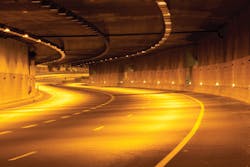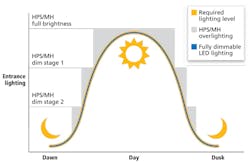LEDs are proving their benefits in most outdoor area lighting applications, but the point sources integrated in solid-state lighting fixtures are an especially good match for tunnel applications. DALE KANE explores specific challenges posed by tunnels and how to address the demanding lighting requirements by combining LEDs with lenses.
The words "dark" and "dingy" appropriately describe many highway tunnels around the world. So when you see a tunnel that is brightly illuminated, with no shadows or dark spots, you may wonder why all tunnels are not well lit. In fact, new installations in many parts of the world demonstrate that well-specified LED tunnel lighting helps a driver's eyes adjust easily and quickly, keeps disruptive maintenance to a minimum, and saves energy while improving light quality.
We will discuss some projects that prove the value of LED-based solid-state lighting (SSL) for tunnels, but justifying such a project remains a challenge. There are two primary considerations that guide the determination as to whether tunnel lighting should be updated to incorporate LED technology. Municipalities typically focus on lifetime cost as well as light quality.
The total cost of ownership for public lighting is a function of several factors including illuminance, power consumption, cost of equipment, cost of installation, maintenance cost, luminaire form factor, and expected lifetime of the luminaire. While other factors that are less quantifiable may be considered, at the authority's discretion the lighting decision can be reduced to determining the lifetime cost of putting a specified amount of light on the ground.
SSL delivers quality lighting
As SSL technology has matured, the quality of such lighting can provide a compelling argument in favor of using such products in tunnels. LED lighting offers superior color rendering compared to common alternatives for exterior lighting such as high-pressure sodium (HPS), which has proven significant enough to warrant a change to existing street lighting systems.
The superior quality of light is highly valued by road users and pedestrians. Some municipalities and utilities have chosen to invest in LED lighting to improve a commercial area, make it more appealing to shoppers and increase the perception of safety and comfort. Sustainability programs and legislation can also play a role in this decision-making process.
In tunnel lighting, it is fair to say that both total cost of ownership and visual perception are factors. However, given the state of public funding, achieving a lower total lifetime cost is typically deemed necessary since any installation must ultimately be paid for out of constrained tax or toll revenues. Fortunately, the latest developments in LED technology have so reduced the purchase and electrical costs of LED tunnel lighting systems that they offer a substantially lower lifetime cost compared to conventional high-intensity discharge (HID) lighting systems, with the additional benefits of SSL systems.
Comparing LED and legacy lighting
Today, conventional HID light sources such as HPS and metal halide (MH) are the workhorses of installed tunnel lighting. Tunnel lighting schemes require a high minimum illuminance to provide a safe environment for users. The luminaires must be capable of delivering high levels of light at a considerable distance from the plane. Typical mounting height in road tunnels is 5–7m (16.4–23.0 ft) to provide clearance for high-sided vehicles.
Both HPS and MH luminaires offer tunnel lighting scheme designers an attractive combination of low unit cost, high illuminance, and proven mechanical construction. Arrays of HPS and MH luminaires typically rate up to 400W per fixture to satisfy the illuminance requirement.
However, the drawbacks of HPS (Fig. 1) and MH luminaires are significant. HPS and MH luminaires use a substantial amount of energy, typically deliver low quality of light, fail to provide uniform and consistent lighting through the tunnel, and suffer from catastrophic failures that require costly maintenance programs to remedy. Now, with the advances in LED technology, tunnel operators have an alternative that is increasingly appealing from both the public and operational perspectives.
The most immediately obvious advantages of LED-based tunnel lights are their long lifetime and efficiency:
• High-quality LED light systems are capable of delivering >100 lm/W in typical tunnel-lighting applications. Since an LED is a directional point source, its light output can be precisely delivered to the required area, which provides additional system efficacy compared to HID systems.
• LEDs are highly reliable semiconductor devices with very long usable lifetimes. The long life of LEDs dramatically reduces maintenance and service costs, poor lighting due to outages, and disruptions to traffic flow due to closures for maintenance.
Lifetime and efficiency
In practice, the difference in lifetime and efficiency between LED luminaires and HID alternatives is marked. German manufacturer Broll recently supplied LED luminaires for the Höllberg Tunnel on the A38 highway (Thüringen, Germany). The linear LED luminaires incorporating Philips Lumileds Luxeon LEDs are rated for 70,000-hr operating life before replacement.
The rated life is equivalent to ten years in service, according to the manufacturer. This extended life contrasts with the typical <30,000-hr lifetime rating for equivalent HPS lamps. Consensus estimates also indicate that LED tunnel lighting typically uses less than half the power of equivalent HPS alternatives.
Regular re-lamping also raises the lifetime cost of HID lights, in comparison to long-lasting LED solutions. The lower energy input costs for LED-based lighting results in significant financial savings in addition to dramatically reducing the carbon footprint of the tunnel's operation. The high efficacy of LEDs is amplified by the technology's support for dimming. In the case of the Höllberg Tunnel, the lamps can be dimmed as needed to save energy and to enable safer and more comfortable driving conditions.
Clearly, the economic decision can be quantified precisely and the lower energy, re-lamping, and maintenance costs of the LED solutions outweigh the lower up-front equipment cost of HPS or MH luminaires over the lifetime of the installation.
Decision-makers may also consider the public's perception of the utility and community. LED lighting is more pleasant and convenient for tunnel users, which further justifies the lighting upgrade.
Superior lit environment
The benefits of LED lighting in road tunnels fall into two main categories: quality of light and reduced impact on traffic flow. The superior quality of light from LED luminaires is due in large part to the superior color rendering of the LEDs. For instance, the ultra-efficient Luxeon T LED from Philips Lumileds offers a minimum CRI of 70. HPS lamps have a typical CRI of 20, and when the two technologies are compared, the LED-based solution produces a more natural-looking environment.
The more faithful rendering of colors across the spectrum can help drivers distinguish objects in the distance better than in the flat, orange-brown light produced by HPS schemes. The environment feels safer and better lit, even when absolute levels of illuminance are identical.
Uniform lighting throughout the tunnel is another benefit of LED-based solutions. Lens designs, developed through the use of advanced optical modeling tools, provide an even, uniform light pattern on the road with neither shadowing nor distracting glare. This uniformity is possible because LED luminaires are made up of arrays of tiny, powerful light sources with beam patterns that can be shaped as required — for example, using total internal reflection (TIR) lenses on each LED to form the desired beam. The result is smoother, more consistent lighting in the entire space without dark spots or very bright spots on the roadway surface.
Ingress and egress lighting
LED tunnel luminaires also allow for enhanced light control in the transitional entrance and exit zones where motorists achieve proper eye adaptation between the outside environment and the tunnel interior. Traditional HPS or MH entrance lighting schemes are designed to mimic the light level of full sunlight at the brightest part of the day, with sections or banks of these luminaires shutting off throughout the day according to the exterior light level (Fig. 2).
In the case of HID lighting, the result of matching exterior light levels can result in over-lighting during most of the day and also a poorer match to the required light level. The fact that HID light levels can't be accurately controlled is the primary culprit. Alternatively, LED-based solutions are fully dimmable, allowing for a precise match to the required lighting level, thereby eliminating over-lighting and lowering energy consumption.
Because LEDs are so robust and do not typically fail catastrophically like an HPS or MH lamp, there is no need to shut down a portion of the tunnel, erect high-level platforms, and perform re-lamping tasks to ensure public safety. This eliminates a tremendous nuisance for the public, keeping lanes open and traffic flowing smoothly in the tunnel.
Weighing the benefits
Recent tunnel lighting projects provide evidence both of the technical viability of LED lighting and of the superior user experience it offers. Examples include the Xinkailing and Wangzhuyuan No. 2 tunnels of the Liu'an-to-Wuhan highway in China, an installation by manufacturer Xi'an Liming (Fig. 3). Both 50W and 100W roof-mounted luminaires were used to illuminate the 2.9-mile length of the tunnels.
European governments are also investing in LED tunnel lighting. In Italy, AEC Lighting installed a scheme in a road tunnel near Florence, using Luxeon LEDs in the luminaires and replacing existing HPS lamps. AEC's solution is the result of many years of research and development effort in AEC Lighting's laboratories, in cooperation with Italian highways authority Autostrade per l'Italia.
AEC used its optical engineering to maximize photometric performance, minimize glare from the light source, and ensure compliance with the photobiological safety requirements for the Exempt Group category imposed by the EN 62471 standard. AEC developed the project for the Italian motorway authority, installing asymmetric floodlights in the tunnel itself and in the entrance zones. Such asymmetric lighting reduces glare by directing beams in the same direction as traffic flow and away from drivers' eyes.
Meanwhile, in the Netherlands, the renovation of the Vlaketunnel (a road tunnel) included the complete replacement of HID lighting with LED lighting. Another LED-lit tunnel is the Heienoord road tunnel, which utilizes Luxeon-based linear lamps to minimize glare and improve visibility.
Tunnel versus street lighting
Indeed, project examples show that LEDs may be an even better match for tunnel lighting than they are for outdoor street lighting. RWS, the Dutch highway authority responsible for road tunnels, is planning more LED tunnel lighting installations. According to Willem Zandvliet, technical manager at RWS, "LEDs are a very good fit for tunnel lighting installations. The lumens required for 1 km of tunnel would illuminate 25 km of outdoor roadway, which means that maintenance of tunnel lighting is very complex and expensive. LEDs give me a significant advantage in reducing maintenance costs.
"We have installed LEDs in multiple tunnels in the Netherlands and for future tunnel projects I am not considering traditional light sources any more. For me, the change to LED lighting is a good example of technology helping me in my business."
For tunnel lighting, the benefits of LED-based lighting systems are compelling:
• improved energy efficiency
• superior quality of light
• uniform lighting
• lower maintenance costs and traffic disruptions
• lower total cost of ownership
The representative projects described in China, Italy, and the Netherlands demonstrate that highway authorities in different parts of the world are recognizing that the combination of superior long-term economics, enhanced utility, and reduced carbon footprint make LEDs the ideal source for lighting along tunnel roads.
DALE KANE is segment marketing manager, outdoor & industrial lighting, at Philips Lumileds.








